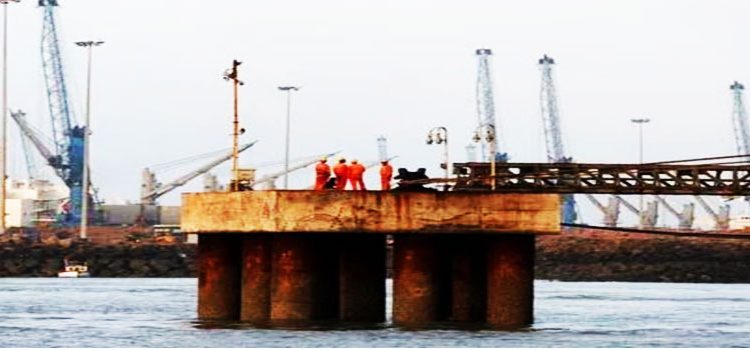It is a sad commentary on the country’s drug investigating agencies that there is so much noise about the arrest of movie star Shah Rukh Khan’s son Aryan and seven others following a raid and seizure of a few grams of drugs during a rave party on board a cruise ship while the seizure of nearly 3,000 kg of heroin worth Rs 21,000 crore at Adani’s Mundra Port in Gujarat went completely unnoticed and uninvestigated. The two incidents, in the span of a few days, have given rise to several disturbing questions. Has the sensational seizure of the contraband brought from Afghanistan not been given due publicity because the Mundra port is owned by Gautam Adani, friend to a couple of the most powerful politicians of India? Is the rave party where a negligible quantity of drugs was found blown out of proportion to divert the country’s attention from the disclosure of the bigger and most dangerous development of Adani’s port being used as a conduit for drug smuggling of staggering proportions? Another question that is uppermost in the minds of the people is whether the rave party is being used to corner and demolish Shah Rukh Khan, known not to be toeing the government’s line, in particular and the Hindi film industry in general for its independence. A series of recent cases related to drug abuse in which some celebrities and their friends and acquaintances of the Mumbai film industry were allegedly involved witnessed motivated investigation and media publicity of staggering proportions. Such a backdrop makes these conclusions inescapable.
What makes the whole case involving Shah Rukh Khan’s son suspect is the dramatic, almost filmy way, in which 22 Narcotics Control Bureau (NCB) personnel disguised themselves as passengers to board the cruise ship to nab the drug abusers, who would have hardly made headlines, had Khan’s son not been in it. The haul made by the NCB team says it all – 13 grams of cocaine, 21 grams of charas, 22 pills of MDMA and 5 grams of MD. Compared to that it defies understanding how the mind blowing quantity of nearly 3,000 kg of heroin could find easy passage to Adani’s port with port officials, the NCB and other investigating agencies being in the dark. It calls for serious investigation how drug cartels could choose this port, while the consignment was for a company based in Vijayawada in Andhra Pradesh. Other ports, including the Chennai port, could have been the obvious choice. The Adani port seems to have become a major hub of drug smuggling in recent times as the seizures indicate.
Aryan Khan’s lawyer pleaded his client had been arrested only on the basis of chat messages and that he had no ticket, no cabin or seat on board the cruise. He didn’t even have a boarding pass and nothing had been found on him. Whether he is a habitual drug abuser can be unearthed by investigators. But, the question is: Can a pickpocket operate in a rail station without police protection? Can organised crime survive without police-politician nexus? The pertinent point is the timing and manner of the raid that appears like making a mountain out of a molehill compared to the massive scale of drug smuggling taking place through ports and other facilities in Gujarat that are owned by powerful people.
In fact, a special court for Narcotic Drugs and Psychotropic Substances in Gujarat has directed the Directorate of Revenue Intelligence (DRI) to investigate if the Mundra Adani Port, its management and its authority have gained any benefits from the import of nearly 3,000 kg of heroin in two containers that landed at the port from Afghanistan via Iran in the name of Aashi Trading Company of Vijayawada in Andhra Pradesh. Additional District Judge CM Pawar hearing the remand application of one of the key accused observed the role of the port authorities and officers need to be investigated. He wondered how the port authorities could be “oblivious” to the fact that such a huge consignment had landed unnoticed in the normal process. The court has also asked the DRI to investigate “the modalities and the process for scanning and checking of such containers and consignments at foreign nations and at Mundra port.”
The court’s reference to the fact that in the last two years, the sea in Gujarat, especially the sea area of Kutch district, has become a hub for “importing/smuggling of contraband in huge quantities from foreign countries like Pakistan and Afghanistan” points to the operations of drug cartels in the state. It cannot be possible that the government of Gujarat and the Centre are not aware of such activities. The Adani port’s Press release claiming its role was “limited to running the port” and that it has no policing authority is also not believable.
No wonder the government’s propensity to resort to theatrics to divert public attention from major issues appears once again to be the main reason for making the young Khan a scapegoat. While drug consumption may not be encouraged with the youth, yet it has to be admitted that drugs are a global problem. There is a need to differentiate between a consumer on the one hand and the criminal drug cartel on the other, whose last mile reach is through the pusher or peddler. A great damage will be caused to society if government puts everyone in the same bracket and punishes equally. As long as the drug lords are not silenced, substance abuse would always exist. Unfortunately it is these powerful drug rings that are in league with the police and politicians who assure them safety and unhindered business freedom. What we are observing in India today is simply political games to divert public attention from more serious issues.






































